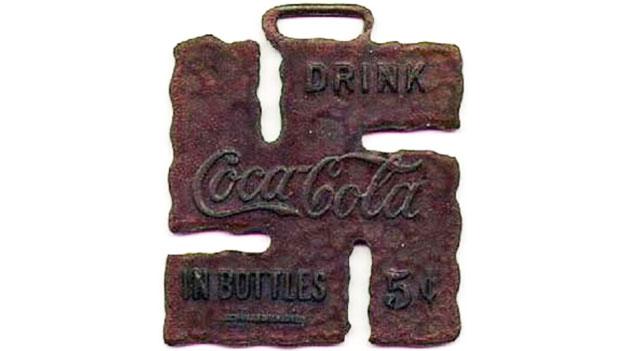Finland's air force quietly drops swastika symbol
- Published

The old emblem for the Finnish Air Force Command (left) featured a swastika, but the current emblem of the force does not
It was long a rather surprising choice of imagery for Finland's Air Force Command - a swastika and pair of wings.
The symbol will always be intrinsically linked with Nazi Germany and its crimes, even though its roots go back many thousands of years.
But now it has been confirmed the Air Force Command has quietly stopped using this unit emblem.
The change was first observed by University of Helsinki academic Teivo Teivainen.
He had previously questioned whether the continued use of the symbol was helpful for the Finnish armed forces.
Finland's air force has been using a swastika ever since it was founded in 1918, shortly after the country became an independent nation and long before Nazism devastated Europe.
Until 1945 its planes bore a blue swastika on a white background - and this was not intended to show allegiance to Nazi Germany, though the two nations were aligned.
While the symbol was left off planes after World War Two, a swastika still featured in some Air Force unit emblems, unit flags and decorations - including on uniforms, a spokesperson for the Finnish air force told the BBC.

This veteran DC-2 plane has been restored and shows the wartime insignia of the Finnish air force
Since January 2017 the emblem for Air Force Command has been similar to the Air Force service emblem - a golden eagle and a circle of wings, the air force said.
"As unit emblems are worn on uniform, it was considered impractical and unnecessary to continue using the old unit emblem, which had caused misunderstandings from time to time," the spokesperson said.

What is a swastika?

The geometric symbol takes the form of a cross with further arms coming off at right angles. The word swastika comes from the Sanskrit for well-being or luck.
It has been used for thousands of years in Indian cultures and worldwide, and became a fashionable motif in the West in the early 20th Century.
However, in 1920 Adolf Hitler adopted the swastika for his National Socialist party, which came to power the following decade in Germany. The genocidal crimes of the Hitler regime mean that the swastika symbolises Nazism and anti-Semitism for most Westerners.
Read more:

Prof Teivainen told the BBC that swastikas could be seen in Finland on buildings dating from the 1920s.
"In Finland there's this idea that it's a random decorative sign - which to some extent it is," he said.
The famed Finnish artist Akseli Gallen-Kallela first used the symbol in a painting in 1889.
The Romantic painter went on to use a swastika as part of his designs for the insignia of the Order of the Cross of Liberty. He used a cross with much smaller hooks, so the visual similarity to Nazi symbolism is much less pronounced. It also features on the official flag of the Finnish president.

The Finnish president's flag features the Cross of Freedom in the top left corner
But the swastika became associated with the Finnish air force via a very different man - a Swedish nobleman called Count Eric von Rosen.
The count used the swastika as a personal good luck charm. When he gifted a plane to the nascent air force of Sweden's newly independent neighbour in 1918 he had had a blue swastika painted on it. This Thulin Typ D was the first aircraft of the Finnish air force and subsequent planes all had his blue swastika symbol too, until 1945.
Supporters of a continued use of the symbol point out that there were no Nazis in 1918 so the air force's use of the swastika has nothing to do with Nazism.
However, while Eric von Rosen had no Nazi associations at the time of his 1918 gift, he did subsequently become a leading figure in Sweden's own national socialist movement in the 1930s. He was also a brother-in-law of senior German Nazi Herman Göring, and, according to Prof Teivainen, a personal friend of Hitler.

This vintage training aircraft performed at an air show to mark the 100th anniversary of the Finnish air force in 2018
The Finnish air force said that, having been von Rosen's symbol, the swastika remains in some Air Force unit flags and decorations, albeit no longer that of the central Air Force Command.
Prof Teivainen told the BBC he had never argued that the swastika should be banned in Finland (as it is in Germany).
But he said the military's duty "is to defend the nation - not to defend an old symbol given by a Swedish count in 1918".
He was concerned that it could affect young Finns' attitude to the military (at a time when male citizens are still conscripted). Finland's huge neighbour Russia might see the symbol as a sign that its neighbour remains an enemy, he thought - and, crucially, could it impact on Western neighbours' attitudes to supporting Finland if the non-aligned nation ever came under threat again?
While the emblem of the Finnish Air Force Academy still features a swastika, external - superimposed with a propeller - the unheralded move away from the old insignia of the central Air Force Command suggests that the military top brass are ready to move on from Count von Rosen and his blue and white swastika.

- Published23 October 2014

- Published14 March 2014

- Published13 February 2024
